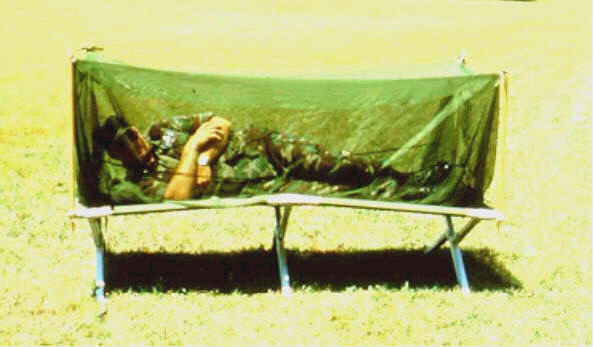Personal Protective Measures Against Insects
and Other Arthropods of Military Significance
|
Introduction This Technical Guide (TG) provides preventive medicine (PVNTMED) information and guidance to Department of Defense (DoD) personnel who may come into contact with nuisance or disease-carrying arthropods (disease vectors), or who are responsible for protecting the health of personnel. It describes the DoD Insect Repellent System and other techniques that provide maximum, safe protection from arthropod attack. These techniques include the use of protective clothing and equipment, repellents, pesticides, and other strategies. This AFPMB TG is based on, and supercedes, U.S. Army Environmental Hygiene Agency (USAEHA) Technical Guide (TG) No. 174, and Personal Protective Techniques Against Insects and Other Arthropods of Military Significance, June 1991, and the Armed Forces Pest Management Board’s (AFPMB) TIM No. 36, Personal Protective Techniques Against Insects and Other Arthropods of Military Significance, August 1996 version. Background a. Historically, in every war and military conflict, combat power has been reduced more significantly by disease and non-battle injuries (DNBI) than from direct combat casualties. A large number of diseases affecting the troop strength of deployed units is directly attributed to disease-carrying arthropods. Moreover, arthropods can inflict severe physical, psychological, and economic stresses that threaten the military mission. Not only do they transmit disease, but the bites they inflict can be painfully distracting and can lead to devastating secondary infections, dermatitis, or allergic reactions. Further, contamination of food and damage to other commodities are costly. b. History is replete with examples of how arthropod-borne diseases have significantly impacted military operations.7,9,13,43 (1) In 1812, Napoleon invaded Russia with 422,000 men. Within three months, seven of every ten soldiers had fallen to epidemic louse-borne typhus, leaving a force of only 100,000. Cold injuries completed the devastation of the disease-weakened force, and by the time Napoleon's Grande Armée retreated out of Russia only 10,000 remained. Dysentary and pneumonia joined with typhus to further reduce the force to fewer than 3,000 living troops. (2) On the American front, in General George Washington's Continental Army, ten Americans died of diseases for every one who died in battle. In the War of 1812, General Andrew Jackson's victory at the Battle of New Orleans in January 1815 was immediately followed by the death of most of the surviving American and British troops from mosquito-borne malaria. During the Civil War, there was a 2:1 ratio in deaths from disease versus combat. In 1898, Army disease casualties included 90,416 cases of malaria, 1,169 cases of yellow fever and 249 cases of dengue fever, with respective fatality rates of 4, 123, and 8 per 1,000 cases. |
(3) During World War I, the ratio of deaths from
disease versus combat in U.S. troops improved to 1:1, but there were
still 16,930 cases of malaria. During World War II, it is estimated
that over 24,000,000 man-days were lost to arthropod-borne diseases.
An entire regiment was rendered ineffective by scrub typhus. Dengue
fever reached a high of 28,292 cases in the Southwest Pacific with 52
cases per 1,000 troops per year. An outbreak of dengue in the New
Hebrides in 1943 affected 26 percent of U.S. forces (more than 6,000
personnel). During the Korean War, U.S. Army forces suffered more than
30,000 cases of malaria, and hundreds of Americans were hospitalized
during a 1951 epidemic of Korean hemorrhagic fever. During the Vietnam
War, diseases accounted for unheralded annual rates of 56 to 74
percent of all U.S. Army hospital admissions. From 1965 through 1970,
the Army lost 2,000,000 man-days to malaria alone. Units operating in
the Ia Drang Valley in 1965 reported an annual malaria rate of 600
cases per 1,000 troops, which rendered two entire battalions
ineffective for a time. Annual epidemics of Japanese encephalitis were
also devastating. (4) In 1993, over 200 cases of malaria were reported
among U.S. military personnel who served in Somalia during Operation
Restore Hope. Dengue virus infections occurred in military personnel
stationed in Haiti as part of Operation Uphold Democracy in 1994, and
cases of leishmaniasis were an outcome of military operations in
Central and South America, and the Middle East in the 1990s. (5) In the United States, tick-borne infections such
as Lyme disease continue to take a toll on troops training in areas of
the Southeast, Northeast, and upper midwest, while newly emerging
infections such as the human ehrlichioses are now posing further
hazards. Nuisance arthropod bites and the diseases they transmit will
continue to be a serious threat to troops in training and in combat. |
Armed Forces Pest Management Board
Technical Guide No. 36
Defense Pest Management Information Analysis Center
Forest Glen Section, Walter Reed Army Medical Center
Washington, DC 20307-5001
Home · Textbooks and Manuals · Videos · Lectures · Distance Learning · Training · Operational Safety · Search
This website is dedicated to the development and dissemination of medical information that may be useful to those who practice Operational Medicine. This website is privately-held and not connected to any governmental agency. The views expressed here are those of the authors, and unless otherwise noted, do not necessarily reflect the views of the Brookside Associates, Ltd., any governmental or private organizations. All writings, discussions, and publications on this website are unclassified.
© 2006 Medical Education Division, Brookside Associates, Ltd. All rights reserved
| Textbook 116 Pages 3.8 MB pdf Download Now |
